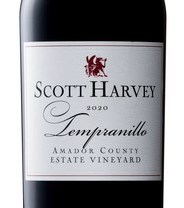Most consumers likely think of Chardonnay, Sauvignon Blanc, Pinot Noir, Merlot, and Cabernet Sauvignon when they think of California wines. Many probably believe Napa = Cab and Sonoma = Pinot. Well, I'm here to tell yah there are other grapes grown that can be purdy good and less expensive than the likes of Pinot and Cab.
This article will focus on what you might call second tier wines. Second tier doesn't mean second class. Some of these wines have been in California since the beginning of wine production, others are relatively new to the state.
 |
| Bordeaux-style blend with Cabernet Franc |
Cabernet Franc
Red Bordeaux is made up of what's known as the king of grapes, Cabernet Sauvignon, plus Cabernet Franc, Merlot, Malbec, and others. In simple terms, Cab Franc is kind of a lightweight Cab Sauv. In blending, it will soften the tannins while adding complexity.
Cab Franc ripens early, so it does well in cooler growing areas. In North America it's found in chilly areas near the moderating effect of water where the growing season is stretched into the fall. You'll find it in Ontario, Michigan, New York and many other states and provinces. In 1986 Casa Nuestra Winery in Napa made the first American Cabernet Franc. Today, most of California's Cab Franc is planted in Napa and Sonoma Counties.
With the interest in wines that are easier to drink when purchased, plus the popularity of Bordeaux-type blends, often call Meritage wines, Cab Franc's popularity is slowly growing.
Grenache
There is a white Grenache, Grenache Blanc, but this is about red Grenache. An easy description is to think of it as Pinot Noir lite. It's well-known in France and Spain, but in California has only been gaining popularity as a single varietal or in a Rhone-style blend in the last couple of decades.
It grows best in hot, dry conditions and tend to be fairly high alcohol wines if not handled properly in the vineyard. Grenache tends to be low in acid, tannins, and color, which makes it a nice, easy drinking wine. These are wines you drink young because they usually don't age well.
Petite Sirah
No, it's not spelled Syrah. Petite Sirah has been in California almost as long as commercial wine production has. If you go back to mid-20th century, you'd find Napa's number one grape would be PS! Some thought of it as a workhorse grape, a blending grape, a jug wine grape. Most of what was made as a single varietal Petite Sirah was low production wines and stayed in the state, though there are now bigger producers getting it on store shelves elsewhere.
It's called Durif in France where Mr Durif crossed Syrah and a grape called Peloursin. It turned out Durif didn't grow well in France, but has found a home in the warmer, drier climates of the U.S., Australia, and Israel.
Somewhat jokingly, I've said Petite Sirah is not a wine for the faint-hearted, or maybe said it'll put hair on your chest. Turns out neither was a good selling point.
Primitivo
It took modern scientific testing to show that Zinfandel is the same as Italy's Primitivo, or at least a fraternal twin. The U.S. government decided you can call it either name on American wine labels. So far, I've never seen anyone make a blend of Zin and Primitivo because that would really confuse the issue. I have read that if you look at the vines side-by-side you can see a difference, and if you taste the wines side-by-side you can taste the difference. Some day I hope to find a tasting of the two from neighboring vineyards and made by the same person.
 |
| Primitivo on the left, Zinfandel on the right |
Rhone Blends
Many American wine drinkers are familiar with Bordeaux blends of Cab Sauv, Merlot, Cab Franc, etc. that may be called a Meritage or given a made up name such as Insignia, Opus One or Cinq Cepages. But you might run across a wine labeled as a GSM and wonder what that means. It's a blend of Grenache, Syrah, and Mourvedre. These grapes originate in the Rhone area of France, where almost all the wines are blends. These grapes complement each other well, making wines that can be bright, with lots of aromas, dried herbs, and peppery.
Tempranillo
Tempranillo is a full-bodied wine that's popular in Spain, Portugal, and the heat of Texas. Tempranillo arrived in California a hundred years ago under another name and was used for blending. Today you'll find it under many different names in different growing areas.
Tempranillo has shown up in only the last couple of decades in California's premium grape growing areas, in Oregon, and in Washington, and is still quite rare. There are about 900 acres of Tempranillo grown in California. That's about 0.2% of the state's total wine grape crop.
Exploring new wines is fun. Give some of them a try.
 |
| From the Sierra foothills |
No comments:
Post a Comment